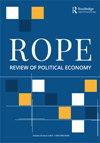货币思想史上的影子货币
IF 1.2
Q3 ECONOMICS
引用次数: 0
摘要
摘要2007 - 2009年全球金融危机之后,学者们将处于危机中心的信贷工具概念化为“影子货币”。由于这一观点似乎与许多既定的货币理论相矛盾,我们将影子货币概念置于货币思想史中,并澄清其意义所在的假设。首先,影子货币的概念源于以市场为基础的货币信用理论,该理论反对货币主要由国家选择以及信用在逻辑上服从于货币的观念。我们通过动员“货币思想矩阵”作为分析工具来解释相关的含义。其次,影子货币概念超越了正统的货币三功能理论,因为它优先考虑记账单位功能作为运作支付系统的基础。这是亨利·桑顿传统的理论立场。第三,影子货币概念假定在货币体系中存在固有的等级制度,在货币形式的边缘存在一系列货币形式,货币的定义变得模糊。信用货币的定义特征是与事先确定的记账单位存在等值关系。我们的结论是,概念模糊的影子货币形式存在于多个历史时代。关键词:信用理论、等级制度、货币功能、全球金融危机、金融创新jel代码:B20E40E44E50致谢我们想借此机会感谢审阅本文并协助其发表的审稿人。披露声明作者未报告潜在的利益冲突。steffen Murau感谢德国研究基金会(DFG)通过拨款415922179和499921148提供的财政支持。本文章由计算机程序翻译,如有差异,请以英文原文为准。
Shadow Money in the History of Monetary Thought
ABSTRACTFollowing the 2007–9 Global Financial Crisis, scholars have conceptualized the credit instruments that lay at its center as ‘shadow money’. As this perspective seems to contradict many established monetary theories, we situate the shadow money concept in the history of monetary thought and clarify the assumptions under which it is meaningful. First, the shadow money concept stems from a market-based credit theory of money which rejects notions that money is primarily chosen by the state and that credit is logically subordinate to money. We explain the associated implications by mobilizing the ‘Matrix of Monetary Thought’ as an analytical tool. Second, the shadow money concept transcends the orthodox three-functions-theory of money because it prioritizes the unit-of-account function as the basis to operate payment systems. This is a theoretical position that stands in the tradition of Henry Thornton. Third, the shadow money concept assumes an inherent hierarchy within monetary systems with a spectrum of monetary forms at the edge of which definitions of moneyness get blurry. The defining feature for credit money is the existence of a par relationship with the ex ante defined unit of account. We conclude that conceptually ambiguous shadow money forms have existed across multiple historical eras.KEYWORDS: Credit theoryhierarchyfunctions of moneyGlobal Financial Crisisfinancial innovationJEL CODES: B20E40E44E50 AcknowledgementsWe would like to use this opportunity to acknowledge and thank the reviewers who reviewed this article and aided in its publication.Disclosure StatementNo potential conflict of interest was reported by the author(s).Additional informationFundingSteffen Murau acknowledges financial support by the German Research Foundation (DFG) through grant 415922179 and 499921148.
求助全文
通过发布文献求助,成功后即可免费获取论文全文。
去求助
来源期刊

REVIEW OF POLITICAL ECONOMY
ECONOMICS-
CiteScore
2.60
自引率
20.00%
发文量
0
期刊介绍:
The Review of Political Economy is a peer-reviewed journal welcoming constructive and critical contributions in all areas of political economy, including the Austrian, Behavioral Economics, Feminist Economics, Institutionalist, Marxian, Post Keynesian, and Sraffian traditions. The Review publishes both theoretical and empirical research, and is also open to submissions in methodology, economic history and the history of economic thought that cast light on issues of contemporary relevance in political economy. Comments on articles published in the Review are encouraged.
 求助内容:
求助内容: 应助结果提醒方式:
应助结果提醒方式:


